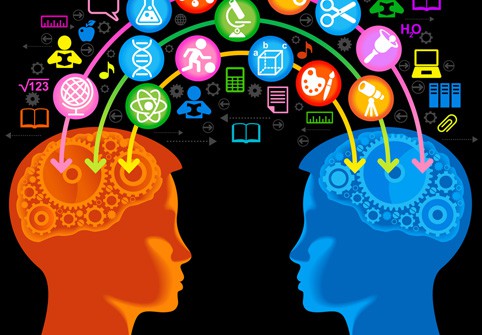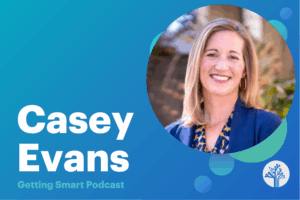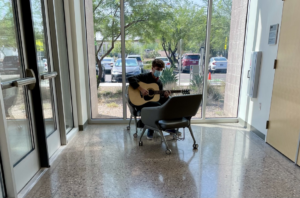5 Characteristics Connecting Montessori Ed & the Personalized Learning Movement

“Before elaborating any system of education, we must therefore create a favorable environment that will encourage the flowering of a child’s natural gifts. All that is needed is to remove the obstacles. And this should be the basis of, and point of departure for, all future education.”
– Maria Montessori, The Secret of Childhood, 1936
At first glance, the intersections between Montessori education and high-quality digital learning are not immediately apparent. To those of us with some knowledge about Montessori methods—based on formal training, general awareness or, as in my case, the observations of a parent whose children attend a Montessori school—its natural materials and deep traditions seem to stand in opposition to the vision of a futuristic, technology-rich digital or blended learning environment.
While a surface look at Montessori learning and digital learning reveals obvious differences, a deep-dive into their undergirding principles reveal a set of very similar core values. Interestingly, these shared values manifest in similar ways in terms of teacher and student roles as they play out in seemingly-contradictory environments. Both high-quality digital learning and Montessori education prioritize the personalization of learning and create systems that allow for customization of content and instruction.
Here are five intersections between Montessori education and digital learning that I’ve observed as a parent to a Montessori preschooler, online educator and an education policy researcher.
1. Individual Learning Progressions & Competency-Based Learning
In both Montessori and high-quality digital and blended learning models, students have control over the path and pace of their learning. For students in a Montessori classroom, this means the choice of “work” that is matched to his/her individual interests, strengths and abilities. Montessori educators are trained to provide students with the next step in a sequence of lessons when the individual learner shows signs of readiness. Technology facilitates students’ progressions through course material in a similar fashion for students in high-quality online and blended environments. In both cases, students move through content based on demonstrations of mastery and their own interests. Because learning is student-centered, student motivation is high.
2. Elimination of Age and Grade Restrictions
Both Montessori and digital learning give less attention to age-based chronological movement through content. The multi-age classroom setting is one of the most well-known features of the Montessori classroom. Rather than moving through traditional K-12 grade bands based on age, students in Montessori classrooms learn alongside their peers in three-year bands. High-quality digital learning provides similar flexibility for students to learn outside of the traditional grade-based system. In both cases, students who need remediation or advanced instruction can do so within the natural learning environment.
3. Formative Assessments & Short Feedback Loops
Assessment in both the Montessori and personal digital learning setting is an organic part of the educational setting. The primary purpose of assessment in both cases is to guide instruction, and therefore ‘testing’ is integrated mindfully and seamlessly into the learning environment. Because assessment is a natural part of the learning environment in both cases, feedback is also immediate and on-going. Montessori lessons are set up to give students opportunities to learn from mistakes in real-time and to self-check their own progress as they complete activities alone or with peers. Online learning opportunities can be set-up to provide similar real-time and on-going feedback.
4. Non-traditional Teacher Roles
In both Montessori and personal digital learning environments, students are active participants in their own learning, rather than learning passively in whole-class lecture-style classrooms. There is more peer-to-peer learning and opportunities for self-guided and informal learning than traditional settings. Since learning comes from multiple places, teachers in both Montessori and high-quality digital and blended learning settings take on varied roles. Teachers in both cases move from traditional roles as experts with the primary task of instructional delivery to facilitators and guides of learning that is personalized and customized to individual student needs. There’s a reason why the teacher in the Montessori settings is referred to as the “Directress”; her primary task is to direct learners to ability-appropriate lessons that students then explore with her guidance and support only as needed. The same is true for personal digital learning settings. The focus is on creating opportunities for discovery and self-learning rather than expecting students to learn primarily from the instructor’s direct instruction.
5. A Global Citizen Perspective
Maria Montessori believed that education had the ability to inspire peace and reconstruct society. The curriculum is built on the importance of instilling a global perspective and respect for the common good from pre-school through graduation. Digital learning presents another route to creating global citizens by removing geographic barriers among learners and connecting students to the world at the click of mouse.
Education systems across the globe are rapidly being propelled into the realities of the future. As policymakers and educational leaders consider how they will create the future of education, there is much to learn from the past. Montessori education, with its deep traditions of child-centered learning and long histories of honoring the unique needs of students, can speak to calls for ‘proof’ that alternatives to traditional K-12 schooling have merit.
For an interesting discussion of the potential of Montessori education to meet the needs of 21st century learners, check out this piece from Forbes about innovators including Google founders Larry Page and Sergey Brin and Amazon’s Jeff Bezos – who attribute their successes to their roots in Montessori classrooms.






Kate
Thanks, Carri, for adding your voice to the connections between Montessori and digital learning. This past August I participated in MOOC MOOC and blogged about my own reflections on Montessori and Participant Pedagogy, check it out: http://ganski.wordpress.com/2012/08/15/participant-pedagogy-montessori-for-higher-ed-moocmooc-day-4/
Cheers,
Kate
Carri Schneider
Thanks for your kind words, Kate. I'll happily add your article to my reading list! Be well, Carri
Adriane G
"The same is true for personal digital learning settings. The focus is on creating opportunities for discovery and self-learning rather than expecting students to learn primarily from the instructor’s direct instruction." This point is one of the only real advantages I see in technologically-innovative teaching versus traditional teaching methods. I worry, as a future educator, will my students be able to revert back to traditional teaching methods if need be? Will they be flexible enough if we continue to so adamantly push learning with technology on our students?
Carri Schneider
Thanks for your comment Adriane. I started as a traditional classroom teacher. Once I became a parent and got to know my own children as learners, I started looking for the best options for them. I came to both montessori and digital/blended learning from that starting point. So far, these are the only two "models" I've seen that prioritize personalization and meet kids where they are. When we empower learners in this way, their "flexibility" becomes an innate part of their experience, and I find they're generally more open to diverse learning experiences in any setting. Here at Getting Smart, we believe that teaching and learning goals should drive technology integration, and not the other way around. Thanks for your comment. Carri
John Bowman
Excellent piece, Carri, great points. This is the type of discussion that will get us somewhere rather than going into our corners with a black and white view of technology vs no technology, especially for preschoolers. Montessori created great numbers of graphic, two-dimensional, image-based materials for use by preschoolers, so Montessori is not strictly 'hands-on', unless you consider holding a card with a graphic image as important because the child is holding an object. An image on a screen is no different than on a piece of paper, except that the screen image can be interactive and so more appealing to a child. Montessori is just as much about the transition to abstract thought from around 3-6 as it is about three dimensional objects. Montessori saw that a marvelous transition in thinking takes place that takes a two year old from a predominately hands-on, neuromuscular approach to exploring the environment, to a six year old's ability to work with printed words and numerals, and to understand concepts mentally & express thoughts verbally. This is the passage into abstract thought, and it is a critical piece of Montessori that many overlook, even experienced Montesorians.
Replies
mark
John - I think this is a stretch. Montessori is clearly, in essence, all about a hands-on experience when compared to conventional ed, which amounts to "teaching as telling". Just because there IS a presence of card material - mostly for language learning, and as you point out, to help with the path to abstraction, doesn't somehow translate to "it's not all hands-on", which implies that it's not SO different, then the slippery slope to "so it's not so different from looking at a computer image. Actually, there is research which shows that a child's interaction with a screen is fundamentally different, and not better, than the tactile experience.
Replies
John Bowman
I understand your point & the resistance to letting screens have a place but, from experience working with hundreds of preschoolers in Montessori environments, I disagree. Maria Montessori constantly acknowledges the passage into abstract thought during the years from 3-6. Most of the Sensorial and Math materials are specifically designed to promote this transition. She even directs teachers not to turn a child's attention to objects when the process of abstraction is foremost at any given time. Three yr. olds spend more time on the object end of a continuum that moves to images, language and abstract thinking as you progress to the other end, which is where six year olds spend a lot of their time. A Montessori environment is designed to promote the transition into abstract thinking because that is a natural & important development task of 3-6 yr. olds. Images and plane figures are a big part of this process, and Montessori included all kinds of them (three part cards, phonics images, progressively more abstract shapes, letters, numerals, etc) in the Primary environment for precisely that reason. She talked often in her books about encouraging the passage into abstract thinking in the 3-6 environment. An image on a card is no different than one on a tablet, except that the tablet uses modern technology to present it. Introduced at the right time, using the best tablet apps, these experiences can enhance and amplify a child's abstract thinking skills. To say that Montessori is only & always strictly about three dimensional object experience is simply wrong, as anyone taking an objective look at the environment and the different ways three yr. olds vs six yr. olds use it. It is more accurate to say that a Montessori 3-6 environment encourages the development of abstract thought through sequential experiences with objects, images, words, and thought.
Carri Schneider
Thanks John, for sharing this perspective and for your kind words! I'm been spending a lot of time lately thinking about what Maria Montessori, a great innovator, would have to say about the tech vs. no tech montessori debate. I have a feeling she'd get us 'out of our corners' too.
Replies
mark
not likely. See my piece in Montessori Today from Jan 2016. The chatter about how Dr. Montessori was an innovator and "even had children introduced to the typewriter" does not mean that she would have embraced tech for the very young. Now, if you;re talking older elementary, then yes, but very few decent, read "real" Montessori schools, don't engage older elem students with basic tech. Primary: fougetaboutit.
Replies
John Bowman
Again, I totally disagree. We can debate the evolution of technology and what our opinions of its proper or improper place in Montessori is, but that doesn't change the fact that children absorb their environment, and technology is now part of it. Again, if you work with children in Montessori you will see three year olds mostly doing Practical Life & Sensorial with real objects, while showing a distinct curiosity about words and numbers. By the time those children are 6, they have developed far greater abstract thinking skills and can conceive of the world mentally. It's a major transition, and one which Montessori recognized and designed her Primary environment to support and encourage. You can debate whether or not you like or dislike including technology in a Montessori environment, but from a perspective of following the child - the core Montessori principle - technology is here and children use it and absorb it. That does not mean they lose something as far as exploring with everything else in the environment goes.
Shari
Hi,
Great article. I can't help but notice similarities in Montessori Method philosophy and Personalized Learning (aka: Kid Friendly). What are your thoughts on this? Are they the same/similar?
Thanks so much for your great article!
Carri
Hi Shari,
Thanks for your comment. Yes, in many ways I think Montessori education is the original "personalized learning." It also offers "proof" that personalized learning can work at scale. There are lots of great models of Montessori schools - public and private - and some with decades of experience in personalized instruction.
Carri
Leisl
Hi Carri,
I was really excited to read your article as I am a big proponent of Montessori education but am in the process of trying to develop a low-cost model which brings in technology for use in South Africa (where we have a major achievements gap and digital divide amongst our kids). I would LOVE to find out more about your research and thinking into this space. How could I get in touch with you to chat further?